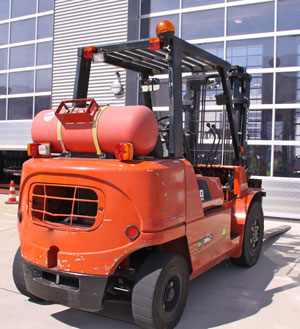KANBrief 4/14

Carbon monoxide (CO) emissions from vehicles and mobile machines may be lethal when the vehicles or machines are used in poorly ventilated environments. LPG (liquefied petroleum gas) engines typically emit less CO than those using petrol or diesel fuel. For CO exposure to be at a safe level, engines must however satisfy the state of the art in terms of their emissions. The state of the art has however yet to be formulated in standards.
Carbon monoxide is highly toxic, since it prevents the blood from transporting oxygen. Once CO has been inhaled, it is absorbed very effectively by the blood. As a consequence, the blood's ability to bind and transport oxygen is strongly impaired or lost for a longer period of time. Acute exposure to CO can cause cardiovascular, neurological and metabolic disorders. A particularly dangerous aspect of CO is that it is tasteless, odourless and colourless, and that other than headaches, it causes virtually no symptoms serving as warning signals. CO poisoning can therefore easily be fatal.
Preliminary survey of the state of the art and exposure
CO emissions from several LPG-engined vehicles (ranging in age from new to 20 years) were measured in a large company in the transport sector. The percentage by volume of CO in the exhaust and the increase in CO concentration were measured in each case in a small, unventilated workshop (volume approx. 400 m³) during test runs of the machines, for example following maintenance work. These tests yielded qualitative information on the state of the art and on differences between older and newer engines.
In addition, exposure measurements were conducted for four drivers of LPG-engined industrial trucks during work in a warehouse with a volume of approximately 25 000 m³.
Findings and further studies
The results showed that all drivers were exposed to carbon monoxide levels exceeding the occupational exposure limit of 30 ml/m³ specified in the TRGS 900 technical rules, despite the fact that the vehicles were only in intermittent use.
The limit value for the CO in the exhaust gas of 0.1% by volume stipulated in the instructions for implementation of the German LPG accident prevention regulation (DGUV Regulation 79) was exceeded by 60% of the vehicles by a factor of at least 2. Correct tuning of the engine had a considerable influence upon the carbon monoxide emissions. Operators of machinery frequently point to better engine running as a justification for incorrect engine tuning, claiming that engines exhibit better throttle response and do not stall as easily. In view of the hazards presented by the exhaust emissions however, these arguments should be irrelevant.
For larger engines (e.g. with 4 cylinders and an engine capacity of 1,600 cm³), the above exhaust limit value also no longer reflects the state of the art, as it can clearly be reduced substantially and without difficulty by the use of modern exhaust treatment technology. Further study suggests that even for smaller engines with a rated power of 6-35 kW, CO exhaust values substantially below 0.1% by volume represent the state of the art and should therefore be incorporated into standards. For example, floor treatment machines (which generally employ smaller engines) are subject to EN 60335-2-72 "Household and similar electrical appliances – Safety – Part 2-72: Particular requirements for floor treatment machines, with or without traction drive, for commercial use". A special national condition applicable only in Germany was added to this standard requiring exhaust gases from machinery intended for indoor use to contain no more than 0.1% CO by volume. Single-cylinder engines are however exempt from this requirement.
Consequences for prevention
• The considerable influence of the engine tune and the long service life of older vehicles confirmed the need for exhaust emissions to be tested and, if necessary, the engine adjusted at least twice a year (Refer to the instructions for implementation of the LPG accident prevention regulation (DGUV Regulation 79)). It is essential that this requirement also be formulated within the instruction handbooks for LPG-engined machinery, and therefore also in the provisions in the standards governing instruction handbooks for new machines.
• Discussion is needed in order for greater clarity to be obtained regarding the state of the art, which can then be reflected in standards.
• The long-term objective must be for only electrically powered machinery to be used in indoor areas wherever possible. In order for this objective to be attained, influence should at the same time be brought to bear upon operators (through information measures conducted by the accident insurance institutions and the labour inspectorates), and in turn by operators upon manufacturers (stricter emission abatement requirements as a purchasing criterion).
Authors: Working group addressing CO emissions from LPG-engined mobile machines.
Ulrich Birkenstock (BG Verkehr), Peter Bollwitt (BGN), Arno Goebel (IFA), Dr Claus-Peter Maschmeier (LAV Saxony-Anhalt), Corrado Mattiuzzo (KAN), Stefan Merkle (BG Bau)